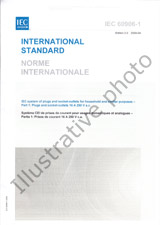We need your consent to use the individual data so that you can see information about your interests, among other things. Click "OK" to give your consent.

IEC 62488-1-ed.2.0
Power line communication systems for power utility applications - Part 1: Planning of analogue and digital power line carrier systems operating over HV electricity grids
Translate name
STANDARD published on 3.7.2025
The information about the standard:
Designation standards: IEC 62488-1-ed.2.0
Publication date standards: 3.7.2025
SKU: NS-1226214
The number of pages: 217
Approximate weight : 682 g (1.50 lbs)
Country: International technical standard
Category: Technical standards IEC
The category - similar standards:
Annotation of standard text IEC 62488-1-ed.2.0 :
IEC 62488-1:2025 applies to the planning of analogue (APLC), digital (DPLC) and hybrid analogue-digital (ADPLC) power line carrier communication systems operating over HV electric power networks. The object of this document is to establish the planning of the services and performance parameters for the operational requirements to transmit and receive data efficiently and reliably. Such analogue and digital power line carrier systems are used by the different electricity supply industries and integrated into their communication infrastructure using common communication technologies such as radio links, fibre optic and satellite networks This second edition cancels and replaces the first edition published in 2012. This edition constitutes a technical revision. This edition includes the following significant technical changes with respect to the previous edition: a) Complete revision of this edition with respect to the previous edition with the main focus on planning of analogue and digital power line carrier systems operating over HV power networks; b) A general structure of a bidirectional point-to-multipoint APLC, DPLC or ADPLC link has been introduced; c) Introduction of a new approach for global frequency planning. IEC 62488-1:2025 s’applique a la conception des systemes de communication par courant porteur sur ligne d’energie analogiques (APLC), numeriques (DPLC) et hybrides analogiques/numeriques (ADPLC, Analogue-Digital Power Line Carrier) installes sur des reseaux d’alimentation electrique HT. Le present document a pour objet de definir la conception des services et des parametres de performance relatifs aux exigences operationnelles en matiere d’emission et de reception efficaces et fiables des donnees. Ces systemes a courant porteur sur ligne d’energie analogiques et numeriques sont utilises par les differentes compagnies d’electricite et sont integres a leur infrastructure de communication a l’aide des technologies de communication habituelles (les liaisons radioelectriques, la fibre optique et les reseaux satellite, par exemple). Cette deuxieme edition annule et remplace la premiere edition parue en 2012. Cette edition constitue une revision technique. Cette edition inclut les modifications techniques majeures suivantes par rapport a l’edition precedente: a) Revision complete de la presente edition par rapport a ledition precedente, portant principalement sur la conception des systemes a courants porteurs de lignes d’energie analogiques et numeriques fonctionnant sur des reseaux d’electricite HT; b) Une structure generale d’une liaison bidirectionnelle point a multipoint APLC, DPLC ou ADPLC a ete introduite; c) Introduction d’une nouvelle approche en matiere de planification globale des frequences.


 Cookies
Cookies
